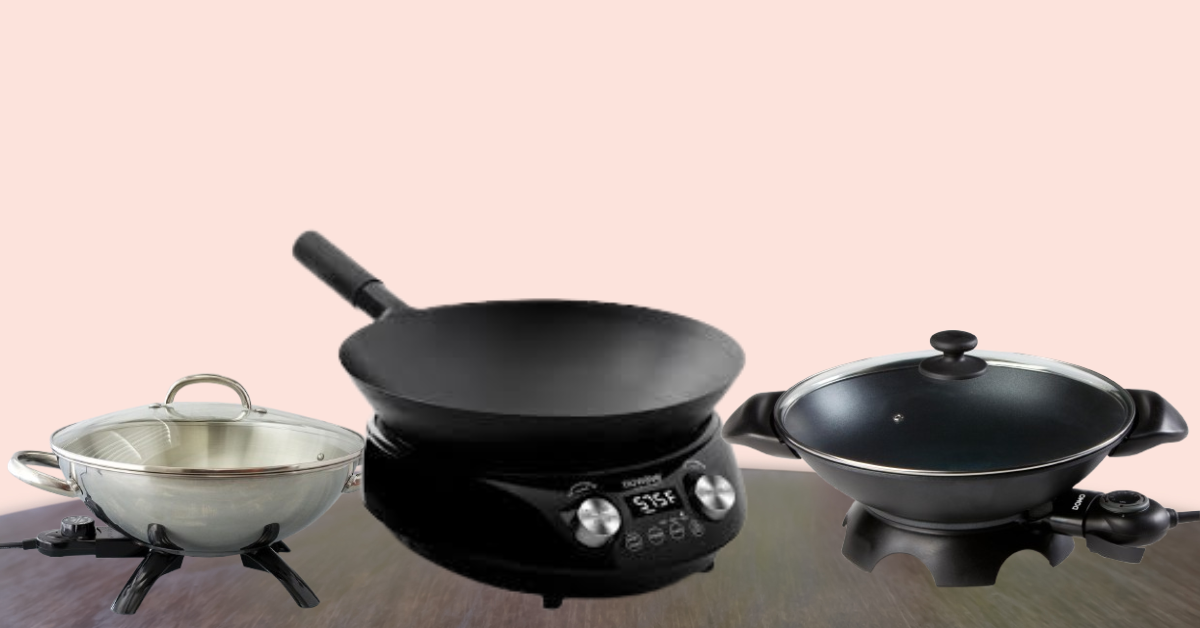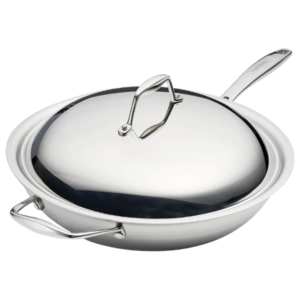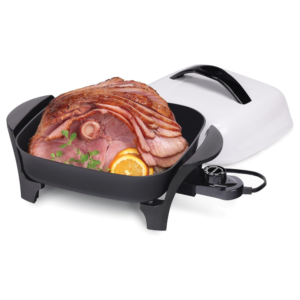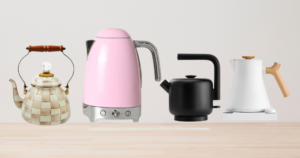In order to provide you with the best product options, our content is painstakingly chosen through independent research, testing, reviews, and AI-driven suggestions. When you make a purchase through our links, it could result in us earning a commission.
In This Article
Cooking at roaring heat adds a primal element and enriches it with a charred, slightly smokey flavor.
This is true whether you’re grilling over a live fire in the summer or simply turning the stove up to high to sear a steak.
A wok, a spherical pan with high edges made for high heat and simple shaking to move ingredients about, is an essential tool for stir-frying in particular.
For your stir-fry to cook and sear without letting your greens get mushy, a wok needs a lot of firepower.
The Cantonese word wok hei, which translates to “breath of the wok,” refers to the unique flavor of food cooked to an extremely high temperature.
You can capture this flavor by using high heat. This characteristic sets a true stir-fry apart from a mediocre sauté.
A commercial wok burner, which is a ring of fire that blasts out heat at many times the power of any household range, is probably responsible for the abundance of wok hei you taste when you order takeout from a Chinese restaurant.
Even if installing a commercial wok burner at home is impractical, individuals will nevertheless attempt to mimic its effects.
This brings us to the electric wok, a relatively recent invention that was introduced to the United States in the early 1985s and did not receive a patent until 1997. Electric woks provide a convenient cooking option for those who want to enjoy the benefits of wok cooking without the need for traditional heat sources.
One The electric wok eliminates the need for a stove, wok burner, campfire, or other external heat source by fastening the millennium-old pan to a base that has a contemporary electric heating element.
Electric woks offer various features that make them a popular choice for home cooks, including temperature controls and the ability to heat up quickly, allowing for an authentic stir-fry experience.
Our Top Picks
1 TRAMONTINA 62158/320 Wok Fry Pan with Lid, 12.6 inches (32 cm)
2 BELLA Electric Skillet and Frying Pan with Glass Lid,
3 Nuwave Pro Chef Induction Cooktop, Commercial-Grade, Portable,
4 Presto 07211 Liddle Griddle and Presto 06620 11-Inch Electric Skillet.
5 Aroma Housewares AEW-306 Electric Wok
Reviews
TRAMONTINA 62158/320 Wok Fry Pan with Lid
The TRAMONTINA 62158/320 Wok is what many have called the best electric wok option because of its amazing ability to cook food the same way a non-electric wok can.
Many consumers believe that the Breville can achieve the ideal temperature for cooking delicious stir-fries, in contrast to the typical complaint that goes along with these gadgets, which is that they simply cannot match the level of heat that traditional woks use to cook their meals.
When the bowl is carrying food, it cannot separate from the base because doing so requires turning it upside down.
Make sure you have enough space to store this wok because it is large—it is 12.6″ in diameter and can hold six quarts.
The only apparent drawback is that the non-stick surface is prone to scratches, but other than that, it is dishwasher safe.
The TRAMONTINA 62158/320 Hot Wok is unquestionably something to give careful thought to if you’re searching for something big, robust, and capable of taking the place of a conventional wok.
Price: $189.95 (When Reviewed)
Speciation
Capacity: 5.2 Liters
Material: Stainless Steel
Item Weight: 2.3 Kilograms
BELLA Electric Skillet and Frying Pan with Glass Lid
The BELLA Electric Skillet and Frying Pan with Glass Lid Wok can be ideal for you if the inevitable flaking of the coating is one of your main worries when it comes to non-stick cookware of any kind.
In addition to being devoid of PTFE and PFOA, the ceramic coating is far more durable than the typical non-stick surface.
Despite being smaller than the other electric wok choices on this list, it is nevertheless capable of producing delectable dishes for multiple people at once.
The one apparent drawback of this specific wok is that the temperature knob is beneath the handle, making it quite challenging to see.
Aside from that, the BELLA Electric Skillet and Frying Pan with Glass Lid Wok is a fantastic choice for anyone searching for something smaller than the other woks discussed thus far and for easy maintenance because of how simple it is to clean and how long-lasting the non-stick surface is.
Price : $38.47(when Reviewed)
Speciation
Included Components: Norpro 99 Favorite Spatula
Material: Tempered Glass, Aluminum, Glass, Copper
Dimensions: 12″D x 12″W x 12″H
Nuwave Pro Chef Induction Cooktop
When it comes to diversity, precision, heat patterns, and control, the NuWave Mosaic induction wok set is unmatched by any other technology available.
It has a degree of temperature control that no rival can match thanks to its induction technology. With three distinct wattage levels for maximum control, it can reach 575 scorching degrees in just one minute and is programmable in 5-degree increments.
The round-bottomed, stick-handled carbon steel wok itself is the second key distinction, and it is the one that makes this model stand out from the others.
It has a completely round bottom for extremely even cooking, unlike stovetop woks that require a flat bottom to rest on, and it is fully removable from the base, allowing you to shake it around freely like a stovetop model.
We are aware of no other electric work that is constructed from conventional carbon steel instead of aluminum or stainless steel.
In addition to being expensive, the wok requires the same amount of seasoning and upkeep as any conventional carbon steel wok.
However, if you’re prepared to spend money on an electric wok of this caliber, you’re also most likely prepared to maintain its cleanliness and condition.
Price : $341.98(when Reviewed)
Speciation
Included Components: Electric Pan
Material: Ceramic
Controls Type: Digital Touch
Presto 07211 Liddle Griddle and Presto 06620 11-Inch Electric Skillet
After testing the Presto 07211, we pronounced the heat management to be excellent. A tiny temperature-control regulator that inserts into the side provides electricity for the stainless-steel flat-bottomed pan, which has stay-cool side handles and feet attached. The remainder of the machine can be cleaned directly in the dishwasher when that electrical component is removed.
You can just fill it with water, heat it up, then use the wooden spatula that comes with it to scrape anything that gets extremely stuck or burned on. You don’t have to worry about oiling and drying this pan.
The Presto’s highest temperature setting is only 400 degrees, and it took a few minutes for the sides of the pan to reach the bottom. However, once the entire pan was hot, it successfully maintained that temperature. We noticed that the edges of the wok were not quite as hot, but the bottom, which was the hottest section, managed to get good searing. Nevertheless, it can also be used for boiling, braising, or sautéing. (The company advises against using it for)
For authentic stir-frying, you can’t really shake it—trying to move the all-in-one device while it’s hot and plugged in would be cumbersome and risky. However, continuous stirring with a spatula or spoon can undoubtedly accomplish the same result.
Price : $89.98 (when Reviewed)
Speciation
Dimensions: 1″D x 10″W x 2″H
Wattage: 1000 watts
Material: Aluminum
Item Weight: 200 Ounces
Aroma Housewares AEW-306 Electric Wok with Tempered Glass Lid
The Aroma AEW-306 5-Quart Electric Wok can be more your style if the models previously mentioned have appeared a bit too big for your needs. Despite being smaller than the previous two woks, with a five-quart capacity and it can still serve small groups.
This device may be used for more than just wok cooking because it also includes a steam rack, a tempura rack, and some frying chopsticks. Its non-stick coating and cast-metal base combine to provide quick, even heating and effortless cleaning.
Although it is dishwasher safe, several customers have complained that the non-stick coating chips easily.
The temperature knob on the side doesn’t increase by specific temperatures, but by regular numbers, but customers have reported this is easy enough to decipher.
The glass lid also comes with an adjustable vent that controls how much steam you want to let out depending on the dish. Overall, a great multi-purpose wok with excellent value for families of 3-6 people.
Price : $160.54 (when Reviewed)
Speciation
Material: Metal
Capacity: 5 Liters
Item Weight: 8.4 Pounds
What to Look For in an Electric Wok
Material : Similar to a stovetop wok, the composition, thickness, and shape of an electric wok have a significant impact on how well it cooks. For electric woks, you essentially have two choices: aluminum, which is lighter and less expensive but tends to cool down more when food is added, and stainless steel, which is heavier and more costly but retains heat better.
We did discover one wok composed of carbon steel, which is stronger than stainless steel and ideal for stir-frying. (It also costs significantly more and needs to be maintained and seasoned after cooking.)Any of these materials may also be nonstick-coated, which is easier to clean and cook with but can’t be used with metal utensils and doesn’t last as long as uncoated metal pans.
Size : A wok’s unique shape is what makes it unique, but the vessel comes in a variety of sizes, ranging from handheld to several feet across. The electric version has a more constrained range, but there are models for larger groups as well as ones for one or two people. Remember that a small change in diameter means a big difference in capacity: a 15-inch wok is nearly 25% larger than a 14-inch one.
However, larger isn’t always better because a larger wok also takes longer to heat up and may be prone to burning small amounts of food, and a larger machine will naturally take up more counter space.
Power : The key to cooking in a wok is heat. Electric woks typically have a power range of 1,200 to 1,800 watts. The more power an electric heating element has, the greater heat it can emit. (This is comparable to how much electricity a domestic stove burner can produce.) Wattage isn’t the only factor, though; the arrangement of the heating components and the composition of the wok all have an impact on performance.
While some electric woks have more intricate forms intended to cook the entire pan more evenly, many just have a spherical heating element that the pan rests on and can heat the bottom more than the sides.
It’s also crucial to think about how much power you can switch off. The fact that an electric wok can be used for a variety of cooking tasks at different temperatures and that certain models provide more and better control over the heat is part of its allure. You may be able to adjust a certain temperature to the degree, or there may be only a few options ranging from low to high.
Shapety : Wok shape matters, too: The bowl-like base and high, flared walls create different temperature zones, allowing some foods to keep warm and others to sear all in one amazing pan. That’s why a regular frying pan or skillet, with its large, flat bottom and short sides, is a no-go for proper stir-frying.
Accessories : Having a lid will allow you to use the wok for other purposes, such as steaming food, although it is not required for stir-frying. A glass lid is better than an opaque one since you can see how the meal is progressing without having to lift it. Some electric woks, like the one we chose for our budget, also include handy accessories like a frying rack, cooking chopsticks, and a steamer platform.
Why Trust The Spruce Eats?
Su-Jit Lin has a strong affinity for food, especially Chinese-American cuisine, a distinctive regionalization of cross-cultural cuisine that is only now starting to gain recognition. She actually grew up in a commercial restaurant kitchen, surrounded by woks and the boom of the open fires that gave them their unique breath. She is the daughter of two generations of immigrant restaurateurs.
That kind of wok-encompassing heat can be channeled by a range (or even just a burner!) in her ideal home kitchen. Nevertheless, she lacks dramatic Chinese culinary skills: She is still incapable of turning a wok—or pan, for that matter—over.
Jason Horn, the writer of Spruce Eats, updated this roundup.
He grew up enjoying the products of a Chinese-American restaurant, Golden Chef, which catered his bar mitzvah and made the best Mongolian beef in the world. Food is also in his blood, even though he didn’t grow up in a Chinese-American restaurant kitchen. He has written on various foods and beverages for almost 15 years.
FAQs
What distinguishes an electric wok from an electric skillet?
Shape is essentially the same factor that distinguishes any skillet from a wok. Round or rectangular, electric skillets have low edges and large, flat bottoms that heat up a little more slowly and softly for sautéing or pan-frying.
A wok features steep, sloping sides and a base that can get really hot and keep food moving while stir-frying. The base might be completely spherical or just have a small flat section.
Aside from that, electric woks and electric skillets function similarly, with pans made of comparable materials and heating components and controls. Electric skillets normally have a power range of 1,000 to 1,500 watts, which is slightly lower than woks because they don’t require temperatures as high.
How does an electric wok work?
An electric wok functions similarly to an electric burner, as does any electrical gadget that generates heat, such as a toaster oven or Instant Pot: It heats up a coil of wire by passing current through it. Dinner is ready when the coil transmits heat to the cooking pot.
Electric woks and similar gadgets must constantly switch on and off to regulate the heat and are not very good at maintaining a set temperature. This is a drawback of electric cooking because the coil can either be turned completely on or completely off.
How do you clean an electric wok?
The instructions for your model will detail the precise procedure, but unplugging the machine and allowing it to cool down is always the first step in cleaning. The majority of electric woks come with a cooking vessel that can be cleaned in the sink after being disconnected from the electrical components.
Additionally, you should stay away from heavy-duty sponges and abrasive cleansers while using certain nonstick woks because they can harm the coating.
Other woks have less maintenance guidelines and can be cleaned in a dishwasher. Try soaking in hot water for a few hours to help get rid of any food that has burned on or become stuck to the wok.
How do you cook in a wok?
Flip-tossing and tumble-tossing are the two methods of cooking in a wok. You can choose between the two cooking methods when you purchase a wok with a long or stick handle.
However, the majority of electric woks cannot be removed while in use and must stay in contact with their bases in order to operate. Toss-cooking is therefore not an option because the standard handle design is short on both sides.
Rather, everything you produce will need to be tumbled, which involves flipping and stirring at the same time along the wok’s walls to combine ingredients and distribute sauce.
Can you deep fry in an electric wok?
Deep-frying is technically possible if the wok can achieve temperatures of 350 to 400 degrees, but most electric woks advise against it since oil can leak or spatter out of the pan and start a fire. However, some versions come with a frying rack and instructions on how to use them for deep-frying. It’s crucial to adhere to the manual’s instructions when doing this, particularly those on the amount of oil to add to the wok.
What is wok hei?
Although it’s hard to describe, wok hei is the essence of stir-frying in a wok. The term “breath of the wok” in Cantonese refers to the complex taste that is added to food by a mixture of the following: smoking oil, vaporizing water molecules, caramelizing sugar, Maillard processes, and the extremely high heat utilized in proper stir-frying.
This combination of caramelized and smoky flavors is difficult to accomplish consistently, which is one of the reasons wok cooking is an art form. You’re making wok hei when the heat is high enough to cause small oil droplets that you swirl into the air to burn and produce miniature bursts of flame over the wok’s sides.
To get more about Kitchen & Dining product you can visit our site .








